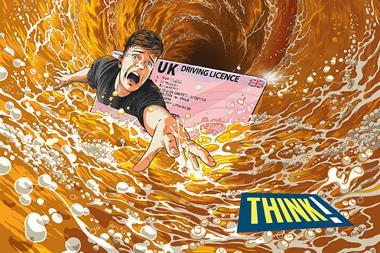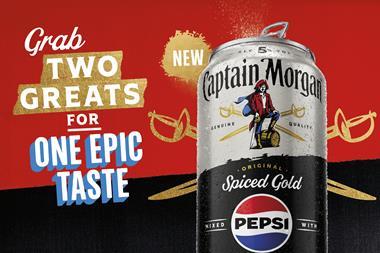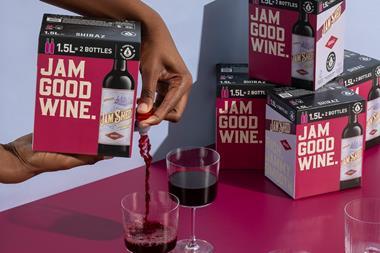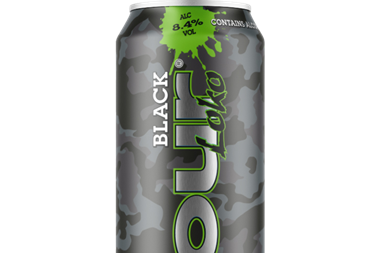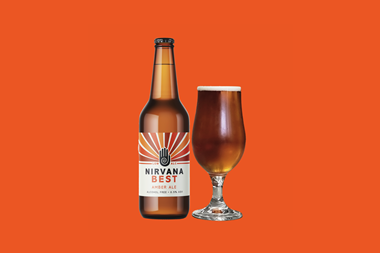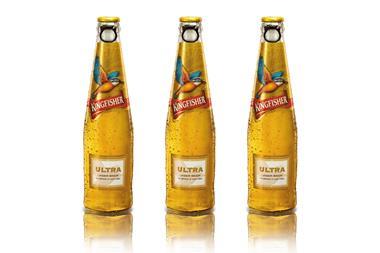The overall spirits category is running to stand still in the independent convenience channel, but the road is smooth for retailers who take advantage of growing trends in format and value, and hone in on fashionable sub-categories.
32%
That’s how much premix is growing in the convenience channel year on year (Nielsen)
Value is down 0.9% in the channel (Nielsen Scantrack February 02, 2013), although cognac, imported whiskey and gin are all bucking the trend with growth of 4.3%, 2.6% and 5.2% respectively (Nielsen MAT March 30, 2013).
Premium brands overall are generally performing above average, too, says Pernod Ricard UK off-trade spirits director Chris Shead. “Although there is a trend in the UK for shoppers switching to cheaper grocery food brands (34%), cutting down alcohol, or switching to cheaper alcohol, remains firmly down their list of priorities (14%) (Nielsen Global Confidence Survey),” he says. As a result, major brands are taking note of such consumer trends to help them develop new and exciting products that provide retailers with solutions, he adds.
Maxxium UK impulse retail controller Ali Brown agrees that retailers need to offer a range of premium brands. “Premium quality continues to play a key role in the independent off trade as shoppers default to brands with heritage that they can trust, and consumers increasingly trade up,” he says.
Your store matters
Diageo has introduced a new category initiative to help retailers drive sales of their alcohol categories. My Store Matters comprises a discussion forum and interactive website, www.mystorematters.co.uk, designed to give advice and support c-store retailers.
Opportunities discussed at the first forum, which was attended by award-winning retailers who sat on the retail panel (pictured right), included growth of pricemarked packs within the premix sector, in-store theatre for launching new products, developing a store’s brand image, raising the bar on execution, and engendering staff loyalty.
This led to the development of category growth drivers, which are shared on the website. They include: range and layout bringing spirits out from behind the counter permanent visibility chillers and premix cans and pricemarked packs.
The benefits of consumers buying spirits - especially premium - in your store are indisputable. According to HIM research, the average spirits shopper typically spends £15.26 each visit, compared with the average of £5.31. Spirits shoppers also visit c-stores more frequently - 4.1 times a week compared with the average 3.7 - thus highlighting the importance of getting your offer right.
The key to ensuring consumers buy premium in the first place is through perception of value. Ramesh Shingadia of Londis Southwater, West Sussex, says that brands on promotion will “always outperform the own label”. But when the brands aren’t being promoted, own brand holds its own.
Pricemarked packs (PMPs) are becoming increasingly common in the convenience sector as a whole, and the spirits category is no different. HIM research found that 90% of convenience shoppers would consider buying pricemarked spirits, while 86% would trust the price of a pricemarked pack over the shelf price.
Brown notes that there is a balance between offering value for the consumer and ensuring the retailer gets an attractive margin, but she says it is a balance which premium brands have got right.
Diageo has introduced a range of PMPs across its major brands, including Smirnoff, Bell’s and Captain Morgan’s Spiced, while Malibu recently added a £12.99 PMP for its 70cl bottle following the successful introduction of a 35cl PMP last year.
Demand for value in premium is also reflected in the growth in 35cl spirits and other fractional sizes. “Retailers should make sure that they stock a range of fractional spirits to ensure shoppers can pick up product on their ‘something for tonight’ shopping mission,” says Diageo category development manager convenience Vicky Mundy.
Fractional sizes account for 30% of spirits sold in the convenience channel, compared with 14% across the total off-trade market, with growth set to continue as they meet the needs of shoppers reluctant to commit to higher unit prices, says Brown. Absolut, for example, has seen its 35cl format grow 54.5% in volume and 59.3% in value, Pernod Ricard points out.
Retailer’s view
“The best-selling premix brands are Jack Daniel’s & Cola and Gordon’s Gin & Tonic, but overall the category is steady rather than spectacular. I think that’s because we have a relatively affluent customer who prefers their bottle of Pimm’s and fresh lemonade.
“Smirnoff and Bacardi are the strongest spirits sellers, followed by own brand across the category. Londis gin outsells Gordon’s, unless Gordon’s is on offer.
“We might trial spirits on the shopfloor as some people don’t shop the fixture as well when it’s behind the counter. Whether there’s enough of an increase to justify taking it out there is open to question. My main reservation is space, as something would have to go to make room for it.”
Roli Ranger, Londis Ascot, Berkshire
Indeed, fractional sizes are a great way to attract shoppers to premium spirits, according to Pernod Ricard research, which found that 37% of shoppers said they would try premium spirits if a smaller format was available. “The 35cl formats make premium spirits accessible at a more attractive price point they encourage trial and are a convenient size for taking to celebrations and social gatherings,” says Shead.
White spirits
Flavoured vodka is growing at 6% ahead of standard vodka in the total off trade and is now worth £27m (Nielsen), Diageo points out. Smirnoff has introduced a new variant to its flavoured vodka range, Espresso Smirnoff, which joins the likes of Smirnoff Lime and Smirnoff Green Apple. Within traditional vodka brands, Smirnoff Red Label is the number one brand, with sales growing 2.2% year on year in the convenience channel. Convenience Store’s ‘top convenience products’ research also found that it is the top-selling spirits brand overall among independents.
Pernod Ricard has launched Absolut Unique, a limited-edition range of unique and individually numbered bottles, each of which is described as a ‘work of art’. The initiative has also included an opportunity for consumers to win an Absolut ‘unique experience’ through a website and neck collar promotion.
Gin’s current resurgence in the white spirits category is being driven by the emergence of new brands, as well as changing consumer tastes and limited-edition creations, says Shead. Pernod Ricard focuses on packaging innovation for its Plymouth and Beefeater gin brands - Plymouth recently introduced new packaging for its portfolio to reflect the brand’s premium quality and rich heritage, while Beefeater’s new limited-edition bottle pays homage to the creativity of Londoners. Available from late June, the design has been developed using 1,000 images crowd-sourced from Londoners who entered the #MyLondon competition last November. Thousands of Londoners submitted photographs of the capital through a specific campaign website.
Meanwhile, Gordon’s gin - currently worth £19m in convenience and the number one gin brand in total off trade (Nielsen) - has launched its biggest ever innovation with the introduction of a new flavoured gin, Gordon’s Crisp Cucumber.
Premix
Gordon’s is also capitalising on the surge in the premix category with Gordon’s & Tonic with a hint of cucumber and Gordon’s & Tonic with a dash of elderflower. Premix is the fastest-growing alcohol segment in the UK, worth £14m and in 32% value growth year on year in the convenience channel (Nielsen MAT March 2, 2013). Diageo says premix shoppers are twice as valuable as the average store shopper, so it is important retailers make space for premix - it advises retailers to set aside 30% of RTD space in the chiller.
Pernod Ricard’s Shead attributes the growth in premix to high consumer demand for a convenience format of their favourite brands that they can take straight to social occasions. “Premix cans provide consumers with a convenient way of purchasing spirits,” he says. “Furthermore, results from our research show that 77% of Malibu can purchases are unplanned, demonstrating a strong impulse opportunity for premix.”
Great shakes
The growth in popularity of the RTD cocktail is currently one of the biggest trends among young adults, according to WKD’s Deb Carter. “This trend first emerged in the on trade and, now firmly established in pubs, it is being mirrored in the off trade,” she says. “RTDs are now increasingly being used as an ingredient for people making cocktails at home, or at social gatherings.”
This provides c-store retailers with the opportunity to generate incremental sales from other spirits and mixers used to make RTD cocktails, she adds.
Cocktail company Funkin has taken advantage of this trend by launching “100% natural” cocktail makers into the off trade. “Retailers can boost summer spirit sales by encouraging consumers to try their favourite spirit in a fruity cocktail,” says Funkin’s CEO Andrew King. “In the past consumers have been reluctant to make cocktails at home, believing it to be difficult, time-consuming and expensive.” Which is where Funkin’s range of mixers come in - consumers only need to add ice and a spirit, he adds.
The range includes Funkin Mojito and Funkin Strawberry Daiquiri. It has also launched Funkin Brazilian, which combines mango, passion fruit and orange juice and is the first cocktail mixer to contain guarana extract, which contains twice the caffeine of coffee beans. Each variant is available for £2.99 in a 750ml pack.
Elsewhere, WKD is tapping into the RTD cocktail opportunity by using Augmented Reality digital technology to create the WKD cocktail recipe-maker app. Consumers can download the free WKD cocktail app or download the Blippar app and pointing their smartphone at WKD 4, 8 and 10 packs or bottle roundels. Users are encouraged to share their recipes.
The number-one premix brand in total off trade is Jack Daniel’s & Cola, which is now worth £10m and growing 35% year on year, says Bacardi Brown-Forman Brands (Nielsen). In impulse, the brand is growing by 65% in volume and 72% in value. “Consumers love the convenience of being able to enjoy their favourite premium brands, such as Jack Daniel’s, in a format handy for occasions when mixing their own drinks is not appropriate,” says Jack Daniel’s marketing manager Crispin Stephens.
“Retailers should stock up on Jack & Cola to make sure they make the most of the increased demand that the spring and summer months are sure to bring.”
Diageo has embarked on a new campaign to educate consumers on the convenience of the premix format, as well as promote its premix portfolio. The campaign, called From the Bar, will be supported by a £2m marketing spend. “We believe that through repositioning premixed drinks and creating greater relevance to the shopper there is a real opportunity to make premix the number one choice for the casual get-together occasion,” says Diageo shopper marketing manager Natasha Chapman. “Given the growing trend for more at-home consumption, the quality, choice and value that premix offers is particularly relevant.”
Diageo’s most recent addition to its premix portfolio is a limited-edition Pimm’s with blackberry & elderflower.
Traditional RTDs, however, have seen a dip in volume over the past 12 months (Nielsen), says WKD marketing director Debs Carter. “We believe this is largely due to the depressed economy which has hit students and young adults in the 18- to 25-year-old age group particularly hard,” she explains. “But, at the same time, they are very brand-aware and certainly haven’t deserted premium brands for the ‘cheapest on display’ - WKD is continuing to outperform its three nearest competitors in the impulse sector (Nieslen).”
WKD has 35% share of the RTD impulse market, followed by Smirnoff Ice (12%) and Jack Daniel’s & Cola (8.5%), Carter claims (Nielsen Scantrack March 2, 2013). As such, it is worth noting that the premix sector still represents 28% of total RTD sales, which should be reflected in traditional RTDs taking the lion’s share of space, she says.
Ones to watch
Raise a glass
First Drinks has launched a limited-edition for its Grant’s and Three Barrels brands, with collectable glasses. For the whisky, a selection of six collectable glasses showcase the evolution of the Grant’s Family Reserve label and the history of the Grant’s name. The first three glasses will be launched in May with the second launched in November to capitalise on the Christmas market.
rrp: £16.49
tel: 01256 748100
Make a splash
Maxxium UK has unveiled Jim Beam Splash, a 330ml premix with its sights set on expanding the RTD sector. First launched in Germany last year, the drink combines Jim Beam White bourbon with lime-lemonade to create a blend aimed at the 18- to 24-year-old market who are after an alternative to the current RTDs. It will be rolled out across the off trade later in the year.
rrp: £1.85
tel: 01786 430500
Taste of summer
Pimm’s has introduced a blackberry & elderflower variant to drive summer sales. It is the first time the brand has released a special-edition version, and the move will be supported by an integrated marketing campaign including POS material and a digital and print marketing campaign. The drink is available in premix cans plus 70cl and 1ltr bottles. Packaging features an illustration of summer hedgerow.
tel: 0845 6025832
Full of beans
Smirnoff is expanding its flavoured vodka range with the launch of Espresso Smirnoff. Available in all channels from April, the new variant is aimed at driving incremental sales in the growing flavoured vodka segment. Espresso Smirnoff joins Lime Smirnoff, Green Apple Smirnoff, Vanilla Smirnoff and Blueberry Smirnoff in the brand’s flavoured vodka range.
rrp: £16.49
tel: 0845 7515101
Source
Robin Mannering
















